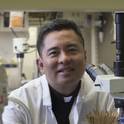
Background
Saccharomyces boulardii is a probiotic yeast routinely used to prevent and to treat gastrointestinal disorders, including the antibiotic-associated diarrhea caused by Clostridium difficile infections. However, only 1-3% of the yeast administered orally is recovered alive in the feces suggesting that this yeast is unable to survive the acidic environment of the gastrointestinal tract. Results
We provide evidence that suggests that S. boulardii undergoes programmed cell death (PCD) in acidic environments, which is accompanied by the generation of reactive oxygen species and the appearance of caspase-like activity. To better understand the mechanism of cell death at the molecular level, we generated microarray gene expression profiles of S. boulardii cells cultured in an acidic environment. Significantly, functional annotation revealed that the up-regulated genes were significantly over-represented in cell death pathways Finally, we show that S-adenosyl-L-methionine (AdoMet), a commercially available, FDA-approved dietary supplement, enhances the viability of S. boulardii in acidic environments, most likely by preventing programmed cell death. Conclusions
In toto, given the observation that many of the proven health benefits of S. boulardii are dependent on cell viability, our data suggests that taking S. boulardii and AdoMet together may be a more effective treatment for gastrointestinal disorders than taking the probiotic yeast alone.
Available at: http://works.bepress.com/nicanor_austriaco/3/
